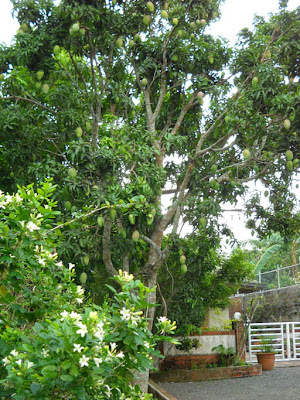Sunday, May 22, 2011
Mango Fever Sets In The Month of May, 2011
May is the month of mangoes. We are all waiting for these green mangoes to ripen.
The idea of picking mangoes myself from my farm was always a vision I had as a little girl. Mangos are my favorite fruits. Filipinos everywhere pride themselves in having the sweetest and most juicy mangoes on earth!
Here are my mangoes still on the tree, right in my driveway at my farm.
Mango Trees are actually equipped with their own self defense. Mango leaves and stems have a poisonous , sticky, white sap that insects do not like. There may be a lot of ants on the tree, but they do not mess with this sap. Birds, and other insects stay away, or merely sit and wait for the mangoes to ripen. That is when everyone races to get to the fruit.
We plant a lot of flowers around the fruit trees to encourage pollinators like bumble bees, honey bees, butterflies to come and do their job in spreading the pollen of the flowers.
Fertilized naturally by these natural pollinators, we do not spray our trees at all with any enhancement chemicals, bloomers, or insecticides.
Bats, birds, insects will then taste the fruit, and once this milky sap turns to sweetness, the mangoes will allow the fruit to be eaten and the seed to drop to the ground and begin a new generation.
We can only eat some of this queen of tropical fruits, but the rest of the fruits will become jams, juice, toppings for cakes, and just enjoyed right off the tree for a wonderful treat!
The luscious taste of the ripe Philippine mango is fabulous. Used in many types of Asian cuisine, from the Japanese "California Maki," to "Mango Chutney", "Mango tarts" and " Mango jubilee" deserts, this fruit is considered a prime export all over the region. I personally love it cut into two halves, and I have one half for breakfast with cottage cheese, and a cup of my own home grown herbal teas. Whichever way you eat it, Mangoes are a treat as precious as gold!
BLOOD LILLIES - The Sign That Summer is over, and Rainy Season Begin
Our farmhand, Danilo points to the lovely red-orange blood lilies.
Some common names for these bulbs include Blood lily, Torch lily, Paintbrush lily, Powderpuff lily, and Fireball lily.
I call them "Powder Puff" Lilies, but their Latin name is :Haemanthus Multiflorus. In some botanical books, these are in the category of Lilies that grow from bulbs like onions. Planted in one spot, they will appear suddenly at the end of summer, after the first deluge of rain falls around the end of May, in the Philippines.
This brilliant, brazen blood lilies are several little, tiny flowers that open together and form a round, delicate powderpuff like ball.
They are a surprise and delight the eyes after a dry, hot summer, these are the sign the monsoon season is at hand.
They have a wide distribution from lowland to mountain forest, but they are very much at home in sun or shade. I placed them in a tiny little "forest" walk near my herbal garden, beside my current empty pond.
They love the sudden moisture of an early rain, but will only shoot up after the rains swell their bulbs with water. Flowers of all species are short‑lived; flower size and coloring differ considerably. After the rains arrive regularly, these will wilt, and then go back to the earth, to rest once more for another year.
Thursday, May 19, 2011
Dendrobiums and Easter Lillies, 2011
I left my dendrobiums in the cooler shade inside my house, near a sunny window in Silang, Cavite. The heat during this summer, 2011 hit 100*F or 35*C and providing the humidity these orchids need, was to water them just before dawn too keep them cool, and let the sun's intensity gradually dry out by noon. The potting materials must dry up before nightfall to avoid any fungus from forming on the leaves.
A few months ago, the group of yellow dendrobiums started to show buds, but I noticed the others that bloomed red I segregated to the side of my house in the semi-shade, were beginning to bloom too.
Quickly, I shifted the position of the orchids to the front porch, and watched them open their buds with the surprise that these plants were naturally pollinated and now had two colors. One group had all yellow, another group had yellow and red petals.
I expected the heat to cause the flowers to dry up and fall off quickly like my oncidiums, that are more delicate , but the yellow and red dendrobiums stayed on for almost 3 weeks!
The Easter Lily popped out of the ground during the Holy Week as scheduled. Nuns at the St. Francis Church at the ridge told me that each year, these lillies will bloom right before Easter Sunday! Sure enough the lillies told me it was definately in time to celebrate Resurrection Sunday.
Subscribe to:
Posts (Atom)










